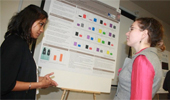Dr. James Lein, Professor of Geography, presents at two upcoming conferences, discussing how remote sensing data can be used to drive sustainability decision making and how earthquake modeling inform hydrofracturing analysis.
Lein discusses “Implementing a Remote Sensing Monitoring System to Support Sustainable Development: The OhioMAP Concept” at the 2013 Ohio GIS Conference on Sept. 12 in Columbus.
“Sustainable development has been broadly defined as a pattern of development that meets the needs of the present without compromising the future,” he notes in his abstract. “At its core, this concept is a form of decision making aimed reducing the negative impacts on the environment while building healthy, resilient communities where the resources needed to achieve a high quality of life can be accessed without exceeding the capacity of our natural ecosystems. Sustainability, as with as decision making process, is a data driven activity with a need to understand how choices made today achieve goals realized only over an extended time horizon. The provision of timely information is essential to guide sustainable develop agendas, but data acquisition is often an uneven process particularly over extend time periods. Remote sensing is a well-recognized approach to document and describe the baseline status of the environmental system, and the capacity of remote sensing systems to provide multi-temporal images of land surface objects enhances our ability to observe the progression of human and natural forces as they act on the landscape. With these capabilities understood, remote sensing assets can play a fundamental role in environmental monitoring as it relates to sustainable development plans. This presentation focuses on the process and strategies of crafting and a remote sensing monitoring system and introduces the OhioMAP concept as an integrated model to support long-term sustainability planning.”
At the 36th Annual Applied Geography Conference on Oct. 31 in Annapolis, MD, Lein discusses “Hazard Characterization of Induced Seismicity in Eastern Ohio: A Hydraulic Fracturing Investigation.” He also leads a panel discussion on remote sensing. Lein is a member of the Applied Geography Conference Board of Directors.
“On December 31, 2011, at 3:04 pm EST a magnitude 4.0 earthquake struck 9 km northwest of Youngstown, Ohio. Although uncommon, earthquakes within the Northeast Ohio seismic zone do occur. However this event, and several smaller tremors recorded beginning in March 2011 were discovered to have resulted from an injection well designed to dispose of waste water generated from hydraulic fracturing operations. Hydraulic fracturing (hydrofracturing) is a common method for extracting natural gas deposits contained with the Marcellus and Utica shale deposits that underlie eastern Ohio,” says Lein in his abstract.
“Recently, hydrofracturing activities have gained traction in the region with over 500 wells permitted, drilled or in production since early 2013. The 2011 Youngstown experience suggests a potential exists for induced seismic events, elevating earthquake risk for communities in the region. In this paper, a scenario event earthquake with an arbitrary epicenter located in northern Carroll County Ohio was simulated using the HAZUS-MH earthquake model. Loss estimation analysis based on the application of two contrasting attenuation functions revealed contrasting patterns of vulnerability that inform the decision-making process regarding hazard preparedness and the potential consequences of natural gas extraction using the hydraulic fracturing technique. The 5.8 magnitude event used to anchor the hazard scenario produced moderate damage to poorly constructed buildings and, depending on ground acceleration and time of day; deaths within the region can be anticipated.”

















Comments